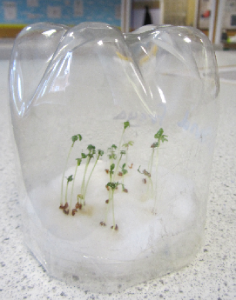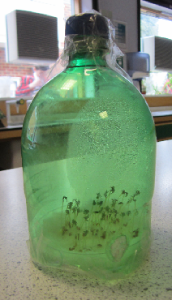Skip over navigation
What conditions are needed for plant growth?
What factors affect the growth of plants?
Build a mini-eco system - a terrarium - and explore what helps plants to grow and what inhibits their growth.

Here are some suggestions, but you may have other ideas:
Or search by topic
Number and algebra
Geometry and measure
Probability and statistics
Working mathematically
Advanced mathematics
For younger learners
Terrariums
Age 11 to 14
Challenge Level 





- Project
- Teachers' Resources
What conditions are needed for plant growth?
What factors affect the growth of plants?
Build a mini-eco system - a terrarium - and explore what helps plants to grow and what inhibits their growth.
Equipment needed
- 2 litre plastic drink bottles in varying colours
- Cress or other seeds which grow quickly
- Petri dishes
- Cotton wool
- Sellotape
Constructing your terrarium
- Put some cotton wool in a Petri dish - you may wish to measure this accurately.
- Count out a specified number of seeds, eg. 20.
- Add a specified amount of water - around 20ml works well.
- Cut the bottle to a specified height or volume - you can use both the top and the bottom ends.
- Put the bottle on top of the Petri dish, as in these photos, and seal the bottle around the dish with sellotape to make a self-contained eco-system.


Running the experiment
You will need to decide what data you want to collect before you start the experiment. You will also need to decide whether to collect data weekly or just after a certain number of weeks. The number of weeks depends on what seeds you use - cress should show significant growth after two or three weeks.Here are some suggestions, but you may have other ideas:
- the number of seedlings which germinate successfully (what criterion will you use to decide when a seedling has successfully germinated?)
- the height of the seedlings - either individual seedlings or the average per terrarium
- the surface area of cotton wool covered - if you decide to focus on this you will need to think carefully about how and where you sow your seedlings on the cotton wool
- the colour of the plants
- their taste (but only if you grow cress or something else which you are sure is edible)

